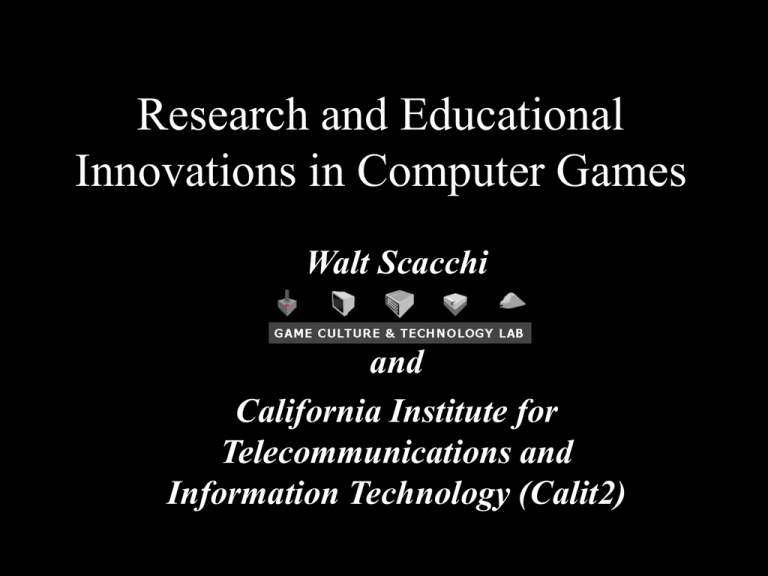Research and Educational Innovations in Computer Games
advertisement

Research and Educational Innovations in Computer Games Walt Scacchi and California Institute for Telecommunications and Information Technology (Calit2) 1 Computer Game Industry • Regional (Silicon Coast, CA) – 70+ game companies in LA-San Diego area – Industry leading game companies in CA: • Electronic Arts, Blizzard Entertainment, Activision, THQ. • International (South Korea, Japan, China, etc.) – 30% of South Koreans play computer games – Games currently 5% GDP; 2012 Goal, 10% 2 Game Industry Map: Silicon Coast 3 Game industry facts • Players: >60% male, average age, 33 years old. (Entertainment Software Association) • Game development costs: – $400K, 1994; $10M, 2005; $15-25M, 2010 (ESA) • Game application areas: military training, corporate training, health care, real estate, manufacturing, etc. • Growth areas: MMOGs, mobile games, education, scientific research, alternate reality games 4 UC Participation in Game Research and Education • Game faculty in UC System – Berkeley (3), Davis (1), Irvine (>10), Los Angeles (3), Merced (1), Riverside (1), Santa Barbara (3), Santa Cruz (3), San Diego (>10), San Francisco (1). • Game faculty interests at UCI and UCSD: – Anthropology, Biomedical Engineering, Communications, Computer Science, Earth Systems Sciences, Education, Electrical Engineering, English, Film and Media Studies, History, Informatics, Physics, Software Engineering, Studio/Visual Arts 5 UCI GameLab Research Partners and Sponsors MASSIVE Research Symposium Corporate Sponsors 6 Game Research: Open Source Game Software Development • The most successful OSSD projects obtain sustained exponential growth in their innovation frontier. • Computer game software development is the #1 application area (and #2 overall) for Open Source Software development (OSSD) projects. – Growing number of commercial computer games now ship with tools for creating OSS game “mods” • Future game development will increasingly depend on global OSSD practices and components. 7 Science Learning Games for Informal Science Education • Physical interaction environment: DinoQuest at the Discovery Science Center (Santa Ana, CA) – Life-size dinosaurs (T. Rex, Argentinosaursus) – Family-based problem-solving and collective learning in physically embodied game play environment – Game progress tracked via user-controlled IR wand that activates embedded electronic media • Online science games: DinoQuest Online – Addresses CA science education standards for K-6 grades – Interoperates with DinoQuest – Designed for internationalization – Developed by UCI GameLab • DSC planning new SLG exhibits through 2010 – >$60M investment – DSC seeking development of network of SLGbase science centers and exhibits – OC, CA, US, Korea, Mexico,Turkey 8 Game-Based Science • Games can employ advanced scientific models, simulations, visualizations – – – – Global Climate Systems Science game engine Nanotechnology-based “incredible machines” Plasma fusion energy generation quest Supply chain/infrastructure transformation quest • Game environments can become platforms for experimentally interacting with emerging scientific models and domains of expertise 9 Game Research Opportunities • UC could partner with a network of regional science centers to create a venue for informal science education via online science learning games and physical interactive exhibits. • UC could lead the development of OSS games focusing on multi-discipline, internationalized educational outreach and public engagement • UC could pioneer R&D for game-based science • UC has the opportunity to lead the development of the Web 3.0: The Game Web 10 Acknowledgements Research results presented here benefitted from support from the: National Science Foundation grants #0083075, #0205679, #0205724, #0350754, and #0534771 Daegu Digital Industry Promotion Agency Discovery Science Center, Santa Ana, CA and others. 11








